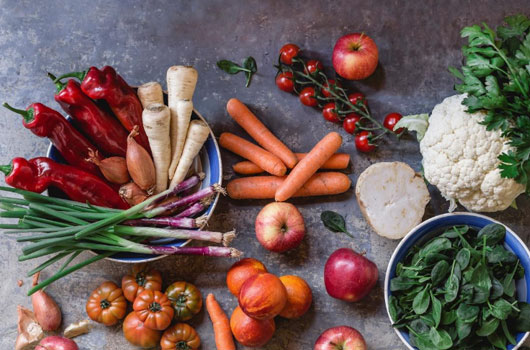The Argument for Whole Foods: A Micronutrient-Rich, Weight-Supporting, Additive-Free Approach to Health
In a world where convenience often trumps nutrition, the case for whole foods—those minimally processed and free from artificial additives—has never been more compelling.
Here, I explore why embracing whole foods isn’t just a dietary choice; it’s a profound act of self-care and empowerment.
Tools that help us bridge the gap between knowing and doing.” know what to do — but can’t seem to do it
Micronutrients—vitamins and minerals—are the unsung heroes of our well-being. They play pivotal roles in immune function, energy production, bone health, and cognitive performance. Yet, research reveals a concerning trend: diets rich in ultra-processed foods (UPFs) often fall short in delivering these essential nutrients.
A comprehensive study in Brazil found that 16 out of 17 micronutrients were present in significantly lower amounts in diets dominated by UPFs compared to those centred on natural or minimally processed foods. Notably, nutrients like vitamins B12, D, E, and minerals such as magnesium and zinc were notably deficient in the ultra-processed segment of the diet (Leite et al., 2015).
This isn’t just a matter of numbers; it’s about the quality of our lives. Micronutrient deficiencies can lead to fatigue, weakened immunity, and impaired cognitive function. By choosing whole foods, we nourish our bodies with the nutrients they crave, fostering resilience and vitality.
Whole Foods and Weight Management: A Harmonious Balance
Weight management is often approached through restrictive diets and calorie counting. However, the quality of our food plays a crucial role in this balance. Whole foods, rich in fibre, healthy fats, and lean proteins, contribute to satiety and metabolic health.
A study focusing on individuals with metabolic syndrome demonstrated that higher consumption of UPFs was associated with adverse changes in weight and other cardiometabolic risk factors over a 12-month period (Micha et al., 2023). Conversely, diets centred on whole foods support sustainable weight management by promoting hormonal balance and reducing inflammation.
In addition to this, research into the thermic effect of food (TEF)—the energy required to digest and metabolise food—reveals a stark difference between whole and processed foods. In a study conducted at Pomona College, volunteers consumed two sandwiches of equal caloric value and macronutrient split, one made with whole grain bread and cheddar cheese, and the other with white bread and processed cheese. The group who ate the whole food sandwich burned 137 calories compared to just 73 calories burned after the processed sandwich (Pomona College Study, 2010). This highlights how whole foods demand more energy from the body to process, contributing to greater caloric expenditure and better weight management.
Embracing whole foods isn’t about deprivation; it’s about choosing foods that work in harmony with our bodies, supporting long-term health and well-being.
The Hidden Costs of Additives and Emulsifiers
Additives and emulsifiers are prevalent in many processed foods, serving to enhance texture, shelf life, and appearance. However, emerging research suggests that these substances may have unintended consequences on our health.
Studies have shown that certain emulsifiers, such as carboxymethylcellulose, can disrupt the gut microbiome, leading to reduced diversity and potential inflammation (Chassaing et al., 2015). While the full implications are still under investigation, the potential risks associated with these additives warrant caution.
Opting for whole foods means choosing ingredients in their natural state, free from synthetic additives, thereby reducing the intake of substances whose long-term effects are not fully understood.
Digestion and the Microbiome: A Delicate Ecosystem
Our digestive system is home to trillions of microorganisms that play a vital role in digestion, immunity, and even mood regulation. The composition of our diet significantly influences the health of this microbiome.
Whole foods, rich in fibre and diverse nutrients, promote a balanced and diverse microbiome. In contrast, diets high in UPFs have been linked to reduced microbiome diversity and increased inflammation (David et al., 2014). This imbalance can lead to digestive issues, weakened immunity, and other health concerns.
By choosing whole foods, we support the thriving ecosystem within our gut, fostering better digestion and overall health.
Identifying Ultra-Processed Foods: A Practical Guide
Understanding the difference between processed and ultra-processed foods can be confusing, especially when both categories might seem to fit within our daily diets. A simple rule of thumb: if a product contains ingredients that you wouldn’t typically find in your kitchen—like artificial colours, sweeteners, stabilisers, and emulsifiers—then it’s likely ultra-processed.
For example, consider jam. A jar of strawberry jam may be processed, but it might only contain strawberries, sugar, and pectin (a natural gelling agent). It’s processed but relatively straightforward. An ultra-processed version, however, may contain high-fructose corn syrup, artificial colourings, and preservatives to extend shelf life and enhance flavour. The key difference lies in the level of industrial processing and the addition of synthetic ingredients.
Conclusion: Whole Foods as an Act of Self-Respect
Embracing whole foods is more than a dietary choice; it’s a commitment to self-respect and holistic well-being. It’s about recognising the profound impact our food choices have on our bodies, minds, and spirits. By prioritising whole, minimally processed foods, we honour our health and empower ourselves to live vibrant, fulfilling lives.
In the words of Brené Brown, “Owning our story and loving ourselves through that process is the bravest thing that we’ll ever do.” Choosing whole foods is a powerful step in that journey—one that nurtures our bodies and honours our inherent worth.
By choosing whole foods over ultra-processed options, we aren’t just improving our diet—we’re shifting the way we relate to ourselves, our health, and our world. It’s a choice to nourish, to respect, and to thrive.
Certainly! Here’s a selection of helpful resources, including a YouTube clip, book, podcast, and the NOVA classification, which will deepen your understanding of ultra-processed foods (UPFs) and whole foods:
YouTube Clip: Ultra-Processed People (UPP)
- Ultra-Processed People: Why Do We Eat So Much Ultra-Processed Food?
- Channel: Ultra-Processed People
- Link: Watch on YouTube
- Description: This video dives into the science and social influences behind the rise of ultra-processed foods in our diets and their impact on health. It’s an engaging and informative visual resource.
Book:
- “Spoon-Fed: Why Almost Everything We’ve Been Told About Food Is Wrong” by Tim Spector
- Description: Tim Spector, a leading researcher on the gut microbiome, dismantles popular food myths and discusses how whole foods, in contrast to ultra-processed foods, benefit both our microbiome and overall health. A great read for anyone looking to understand the science behind nutrition and digestion.
- Link: Spoon-Fed on Amazon
Podcast:
- “The Tim Spector Podcast”
- Description: Tim Spector’s podcast explores the science of nutrition, the gut microbiome, and the impacts of modern diets. In various episodes, Spector goes in-depth about the detrimental effects of ultra-processed foods and the benefits of eating whole foods.
- Link: The Tim Spector Podcast
- Recommendation: Start with episodes discussing gut health and the microbiome to understand the importance of whole foods.
The NOVA Food Classification System:
- NOVA Classification Overview
- Source: Brazilian Institute of Health (IBS) / University of São Paulo
- Description: The NOVA classification system categorises foods based on their level of processing. Foods are classified into four groups:
- Group 1: Unprocessed or minimally processed foods (e.g., fruits, vegetables, meats, grains).
- Group 2: Processed culinary ingredients (e.g., oil, butter, salt, sugar).
- Group 3: Processed foods (e.g., canned vegetables, cheese, smoked meats).
- Group 4: Ultra-processed foods (UPFs), which are industrially made foods with additives like artificial colours, flavours, and preservatives (e.g., packaged snacks, sugary drinks, ready-to-eat meals).
- Resource Link: The NOVA Food Classification
These resources will give you a multi-faceted look at the significance of whole foods, the harm of ultra-processed options, and the scientific reasoning behind it all. They complement each other beautifully, giving you both theoretical and practical knowledge.








